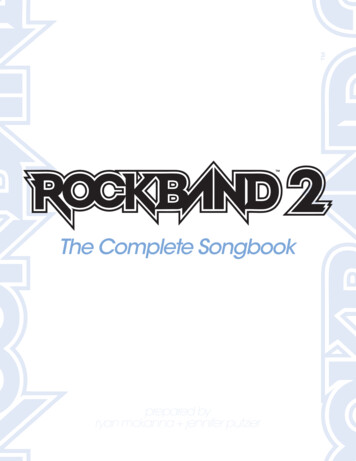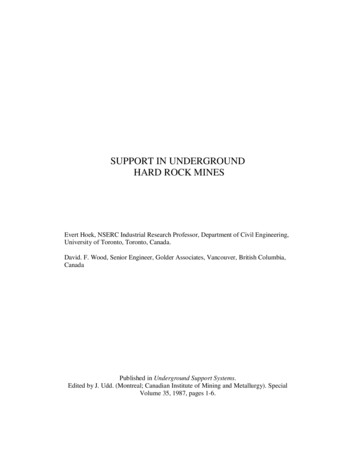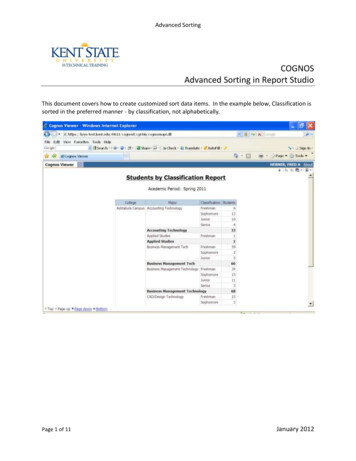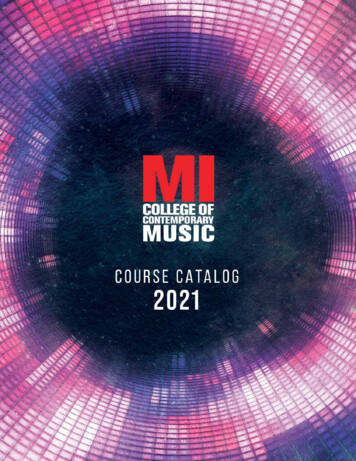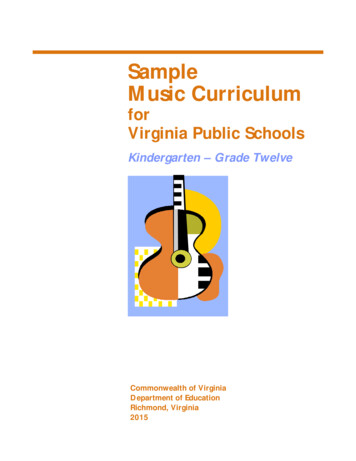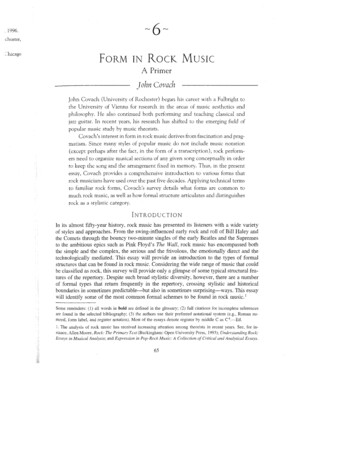
Transcription
l1996.chuster, hicagoFORM IN ROCK MUSICA PrimerJohn CovachJohn Covach (University of Rochester) began his career with a Fulbright tothe University of Vienna for research in the areas of music aesthetics andphilosophy. He also continued both performing and teaching classical andjazz guitar. In recent years, his research has shifted to the emerging field ofpopular music study by music theorists.Covach's interest in form in rock music derives from fascination and pragmatism. Since many styles of popular music do not include music notation(except perhaps after the fact, in the form of a transcription), rock performers need to organize musical sections of any given song conceptually in orderto keep the song and the arrangement fixed in memory. Thus, in the presentessay, Covach provides a comprehensive introduction to various forms thatrock musicians have used over the past five decades. Applying technical termsto familiar rock forms, Covach's survey details what forms are common tomuch rock music, as well as how formal structure articulates and distinguishesrock as a stylistic category.INTRODUCTIONIn its almost fifty-year history, rock music has presented its listeners with a wide varietyof styles and approaches. From the swing-influenced early rock and roll of Bill Haley andthe Comets through the bouncy two-minute singles of the early Beatles and the Supremesto the ambitious epics such as Pink Floyd's The Wall, rock music has encompassed boththe simple and the complex, the serious and the frivolous, the emotionally direct and thetechnologically mediated. This essay will provide an introduction to the types of formalstructures that can be found in rock music. Considering the wide range of music that couldbe classified as rock, this survey will provide only a glimpse of some typical structural features of the repertory. Despite such broad stylistic diversity, however, there are a numberof formal types that return frequently in the repertory, crossing stylistic and historicalboundaries in sometimes predictable-but also in sometimes surprising-ways. This essaywill identify some of the most common formal schemes to be found in rock music. 1Some reminders: (1) all words in bold are defined in the glossary; (2) full citations for incomplete referencesare found in the selected bibliography; (3) the authors use their preferred notational system (e.g., Roman numeral, form label, and register notation). Most of the essays denote register by middle C as C4.-Ed.1. The analysis of rock music has received increasing attention among theorists in recent years. See, for instance, Allen Moore, Rock: The Primary Text (Buckingham: Open University Press, 1993); Understanding Rock:Essays in Musical Analysis; and Expression in Pop-Rock Music: A Collection of Critical and Analytical Essays.
66ENGAGING MUSICGenerally speaking, harmonic structure tends to be a primary factor in determiniiformal units at all levels of structure. Typically the analyst determines the meter of tlsong, analyzes the chord progressions, and charts the number of measures in a sectioconsidering phrases within that section where applicable. These sections then add uparticulate the form of the song, which will often fall into one of the general types that wbe explained below. In considering form in rock (as in many other types of song), italso helpful to separate out harmonic concerns from those regarding the lyrics, at leeprovisionally. As will be shown, for instance, the pacing and repetition of harmonic mterials need not always align with that of the lyrics: lyrics can be repeated over differesets of chord progressions, and the same progression can support different lyrics. It is thhelpful to remain mindful of the dialectical tension that can arise between these dimesions of the musical fabric, as such relationships can be useful in making important femal distinctions (as will be seen below). Organizational schemes in the melodic, timbr.textural, and rhythmic dimensions frequently reinforce those found in the harmonic allyric dimensions of a song, though detailed analysis will often reveal distinct schemes tlcomplement the overriding formal one. The common strategy of building up an arrangment by adding new layers to the texture as a song progresses, for instance, is one eample of such a scheme. The form of a song is thus only one aspect of its structure.For the purposes of this broad introductory survey, consideration will be limitedthe twelve-bar blues as an organizational pattern and to several formal types: AABA, cctrasting and simple verse-chorus, simple verse, and compound forms. A wide range fmal variation in rock music can be understood in terms of these basic schemes, and whthese schemes cannot account for all rock, they offer a solid foundation for the fomanalysis of much rock music. This essay should be studied with the recordings of tsongs discussed below readily at hand. The examples provided for discussion are weknown songs in the style-all of them are hit records that are likely to be both familand easily accessible to most readers who listen to rock music. In general, earlier sonhave been chosen over later ones, though no claim is made that any of the songs is tfirst instance of a given formal type.THE TvVELVE'" BAR BLUESThe influence of post-World War II rhythm and blues on rock and roll in the 1950sobvious in many ways. In the great rush toward providing music for the craze createdthis new youth-oriented musical style, many white acts re-recordedsongs that had 1come hits for black artists on the rhythm and blues charts. These "cover" versions WIin many cases hardly different from the originals, though frequently lyrics were changto remove references that white middle-class listeners might find offensive. As these co'versions climbed the pop charts, original rhythm and blues recordings of other songs acharted, crossing over from the rhythm and blues charts to the pop ones. These crossovand covers make up much of the original rock and roll of the mid 1950s. 22. For a fuller account of cover versions and crossover hits in the 1950s, see Charles Hamm, Yesterdays: Fular Song in America (New York: W. W. Norton, 1983), 391-424; Steve Perry, " Ain't No Mountain HEnough': The Politics of Crossover," in Facing the Music, ed. Simon Frith (New York: Pantheon, 1988),51David Brackett, "The Politics and Musical Practice of 'Crossover,''' in Popular Music: Style and Identity,ternational Association for the Study of Popular Music Seventh International Conference on Popular MiStudies, ed. Will Straw, Stacey Johnson, Rebecca Sullivan, and Paul Friedlander (Montreal: Centre for Reseron Canadian Cultural Industries and Institutions, 1995),23-31; and John Covach, "Jazz-Rock? Rock-Jazz? Sistic Crossover in Late-I 970s American Progressive Rock," in Expression in Pop-Rock Music, 113-34.
67FORM IN ROCK MUSICMeasures(beats)ChordsPhrases2I1234 12343123441234(IV)Question --------------------156IVIV7Question again8910VIVII12VAnswerExample 6.1. The twelve-bar blues (Muddy Waters, "Train Fare Blues" [1948])rsyed:roS)-;h7"7-ic:h1-In terms of organizational patterns, one clear model for much rock and roll-sincethe 1950s and up to the present day-is the twelve-bar blues. This pattern derives mostlyfrom the kinds of blues played by blues and jazz bands in the years before the SecondWorld War; while solo blues artists were sometimes much freer in terms of phrasing andmeter, musicians playing together in a group setting were able to play easily by simplyfollowing this twelve-bar scheme. Good examples of this pattern may be found in trackssuch as Muddy Waters's "Train Fare Blues" (1948), Howlin' Wolfs "Evil" (1954), andmany others."The pattern is made up of three phases, each four measures in length (see example6.1). The first phrase prolongs the tonic harmony. The second phrase moves to the subdominant for two measures and then returns to the tonic for two measures. The lyrics andmelody from the first phrase are often (though not always) repeated in the second, making the second phrase a contrasting restatement of the first. The third phrase moves fromdominant harmony through a passing subdominant harmony to tonic, while offering contrasting lyrics and melodic material. The musical effect of these three phrases can be understood as analogous to posing a question, reposing the same question, and then providing an answer, and this scheme serves to unify the three phrases into a single twelve-barunit that then can be repeated as many times as the musicians see fit. Improvised solostend to respect this question-question-answer scheme as well, frequently withholding thestrongest melodically cadential material for the conclusion of the third phrase.Big Joe Turner's "Shake, Rattle, and Roll" provides a nice example of the twelvebar blues in a rock and roll context. In light of the discussion above, it is worth notingthat this tune was a rhythm and blues hit for Turner in 1954 but became a pop hit whenBill Haley and the Comets covered it in 1955. A formal diagram of Turner's version of"Shake, Rattle, and Roll" can be found in example 6.2. 4 Note that after a four-measureintroduction vamping on the tonic chord, the remainder of the tune consists of eight timesthrough the twelve-bar blues in the key of Eb. This song follows the practice of repeating the lyrics to the first phrase in the second, with the third phrase offering the completion of the idea that began in the first two. The song differs somewhat from traditionalblues by providing a chorus (the catchy "shake, rattle, and roll") in which the lyrics remain constant each time it sounds. This verse-chorus scheme based on the twelve-barblues can be found in many other early rock and roll hits, including Bill Haley and theComets' "Rock around the Clock" (1955) and Chuck Berry's "Johnny B. Goode," thoughthese songs do not repeat the first-phrase lyrics of the verse in the second phrase. A sue3. See Dave Headlam, "Blues Transformations in the Music of Cream," Understanding Rock, 59-92; and "Doesthe Song Remain the Same? Questions of Authorship and Identification in the Music of Led Zeppelin," in Concert Music, Rock, and Jazz since 1945: Essays and Analytical Studies, ed. Elizabeth West Marvin and RichardHermann (Rochester, N.Y.: University of Rochester Press, 1995), 313-63, for detailed consideration of howblues models make their way into British rock in the 1960s and 1970s.4. The formal diagrams provided in this study provide both measure counts and CD timings. CD timingsshould be understood as approximate, since some deviations can occur between re-released versions of thesame recording.
68ENGAGING MUSIC0:00-0:07Introduction, 4 mm.0:07-0:250:25-0:430:44-1:021:02-1 :211:21-1 :401:40-1 :581:58-2:172:17-2:362:36-3:00Verse, 12 mm.Verse, 12 mm.Verse, 12 mm.Chorus, 12 mm.Verse (instrumental), 12 mm., sax soloVerse, 12 mm.Chorus, 12 mm.Verse, 12 mm.Chorus with ending, 12 mm.verse twelve-bar blues inEb, as shown above without optional harmonies in parenthesisExample 6.2. Big Joe Turner, "Shake, Rattle, and Roll," words and music by Jesse Stone (Charles Calhoun),produced by Ahmet Ertegun and Jerry Wexler. Reached no. 1 on the Billboard Rhythm and Blues Chart in late1954.cession of twelve-bar verses without chorus can be found in Elvis Presley's "Hound Dog"(1956) and Little Richard's "Lucille" (1957), among many others. Discussion below willfocus on larger formal issues concerning these songs. For present purposes, it is enoughto point out that despite a certain amount of variation in the handling of the lyrics andmelodic material, a formal scheme consisting of repetitions of the twelve-bar harmonicpattern made up of three four-bar phrases remains constant among all these tracks.The twelve-bar pattern can itself be modified, leading to eight-bar and sixteen-barschemes. Example 6.3 shows Elvis Presley's "Heartbreak Hotel," in which two four-barphrases replace the three phrases discussed above. In this case, the first phrase is consistent with the twelve-bar version while the second is not. This second phrase can be seenas something of a conflation of the second and third phrases found from the twelve-bararrangement, with mm. 5 and 6 matching the beginning of phrase 2 while mm. 7 and 8do not strictly correspond to any pair of measures from the twelve-bar pattern. These lasttwo measures serve to drive the eight-bar pattern to harmonic closure, and in this way canbe seen to parallel-at least in function-the last four bars in the twelve-bar scheme. Example 6.4 shows a sixteen-bar scheme, and a comparison with the twelve-bar version inthis instance reveals much clearer parallels. The first phrase of Elvis Presley's "JailhouseRock" expands the usual four measures to eight, while the remainder of the pattern duplicates the second and third phrases of the twelve-bar blues. While the harmonic schemesof these tunes have clear links to the twelve-bar pattern, both "Heartbreak Hotel" and"Jailhouse Rock" break with the question-question-answer lyric pattern of the :211:21-1:421:42-2:05Verse, 8 mm.Verse, 8 mm.Verse, 8 mm.Verse, 8 mill.Verse (instrumental), 8 mm., 4 mm. guitar 4 mm. of pianoVerse with ending, 9 mm.verse E: I I I I I I I I1234IV I IV I V I I II5678Example 6.3. Elvis Presley, "Heartbreak Hotel," words and music by Mae Boren, Tommy Durden, and ElvisPresley, produced by Steve Sholes. Reached no. 1 on the Billboard Pop and Country Charts in early 1956;reached no. 5 on the Billboard Rhythm and Blues Chart.
FORM IN ROCK MusIc0:00-0:06Introduction, 4 mm.0:06-0:290:29-0:520:52-]: 15]:]5-1:261:26-1:481:48-2:112:11-2:21Verse, 16 mm.Verse, 16 mm.Verse, 16 mm.Partial Verse (instrumental), 8 mm.Verse, 16 mm.Verse, 16 mm.Fade on Vampverse 8 :I I I I I I I I I I I I I I I I12345678IY I IV I I I I I910 II 1269V I IV I I I I II13 14 15 16Example 6.4. Elvis Presley, "Jailhouse Rock," words and music by Jerry Leiber and Mike Stoller, producedby Steve Sholes, Jerry Leiber, and Mike Stoller. Reached no. 1 on the Billboard Pop, Country, and Rhythm andBlues Charts in late 1957.AABAFORMWhile the twelve-bar blues addresses how a verse or chorus may be constructed, in termsof overall form, this scheme only requires that the twelve-bar (or eight- or sixteen-bar)pattern be repeated, determining little about the specific larger form of a song. Rock music does operate according to a number of larger formal designs, however, and one frequently employed formal scheme in rock music is the AABA pattern. While this formcan be found in much music in the Western tradition, rock musicians have been influenced most by the use of the thirty-two-bar AABA scheme in American popular songduring the first half of the twentieth century." While other thirty-two-bar schemes can befound among Tin Pan Alley pop songs, the formal design shown in example 6.5 is oneof the most common. After a four-measure introduction, the first verse of "Over the Rainbow" consists of eight bars, which are then repeated for the second verse. Note that theverses are harmonically closed, cadencing in the home key of Ab major. The eight-barbridge presents contrasting material, and while it does not modulate in this instance, modulations during this section-often referred to as the "middle eight"-are common. Thebridge is harmonically open, ending with a dominant sonority in the home key that pre-0:00-0:1 ]Introduction (4 mm.), Ab: I0:11-0:340:34-0:550:55-] :181:18-1:40Verse (8 mm.)Verse (8 mm.)Bridge (8 mm.)Verse (8 mm.)1:40-2:012:01-2:252:25-2:46Verse (8 mm.)Verse (8 mm.)Partial Bridge (4 mm.)IIIIIiv V7 17/iii777verse Ab: I vi I iii y 7/IY IIY viioI iii y /ii Iii iv I I y /ii I ii y 1 I (Y) I9bridge Ab: I I Y71 I I ii Y I I I Y7/iii I iii I ii y #slExample 6.5. Judy Garland with Victor Young and his Orchestra, "Over the Rainbow," words by E. Y. Harbaugh, music by Harold Arlen. Reached no. 5 in the Billboard Pop Chart in fall 1939.5. For a fuller analytical account of the music of Tin Pan Alley songs during this period, see Allen Forte, TheAmerican Popular Ballad of the Golden Era, 1924-1950.
70ENGAGINGMusIC0:00-0:08Introduction (4 mm. prolongation of G: V drawn from d)0:08-0:290:29-0:510:51-1:111: 11-1:33Verse (12 mm., 40 40 4b)Verse (12 mm.)Bridge (II rnm., 4(; 7d)Verse (12 mm.)I :34 1 :541:54-2:22Bridge (II mm.)Verse with tag (15 mm., 4aa G:b G:c C:d C:e40 7e)I I V I vi I iii IIV V I I vi I IV V I I Iii I V I I I vi IiiIVIIG: IV I V I V I V I V IG: IV V I I vi I IV V I III I IV V I IV I I IIExample 6.6. The Beatles, "I Want to Hold Your Hand," words and music by John Lennon and Paul McCartney, produced by George Martin. Reached no. 1 in UK charts in late 1963 and no. 1 on the Billboard Pop Chartin early 1964.pares the return of the verse. The last verse returns after the bridge, rounding out a thirtytwo bar scheme made up of four eight-bar phrases that can be labeled AABA overall.It is important to note that Tin Pan Alley songs typically consist of two sections, often called the "verse" and the "refrain" but perhaps better labeled the "sectional verse"and "sectional refrain." The sectional verse is a kind of lead-in to the song, with lyricsthat set up the sentiment expressed in the sectional refrain. The sectional verse tends notto be heard much in modern performances, and the sectional refrain is what most listeners would recognize as the song itself. Example 6.5 thus accounts only for the sectionalrefrain of "Over the Rainbow," and care must be taken not to confuse the term "verse"as it is used in this example from the other sense of the term, used to describe a largersection that is not under analytical consideration here. Singers and big bands frequentlydispensed with the sectional verse, and recorded versions of Tin Pan Alley songs usuallyfeature the complete thirty-two bar sectional refrain, which is then repeated within thetime constraints of the 78 rpm record of the time. In the case of "Over the Rainbow," thefull AABA scheme is followed by an abbreviated reprise featuring two verses and anending crafted out of material drawn from the bridge.Professional songwriters in the late 1950s and early-to-mid 1960s (especially thoseworking out of the Manhattan's Brill Building) frequently employed modified versions ofthe thirty-two bar AABA form that was standard among the earlier Tin Pan Alley songwriters. Individual sections often deviated from the eight-bar model, with verses sometimes running to twelve or sixteen bars, and bridge sections may also have exceeded eightmeasures in length. Under the influence of these American songwriters, John Lennon andPaul McCartney also employed the AABA form with abbreviated reprise in many of theirearly British-invasion hits. Example 6.6 shows the formal design of "I Want to Hold YourHand." Note that after a four-measure introduction, the verses are each twelve measuresin length. Harmonic progressions are represented by italic lowercase letters (see the bottom of the example), and thus 4a 4a 4b in the first verse indicates that four measures of the a progression are repeated and followed by four measures of the b progression.? The bridge is modeled on the eight-bar scheme, with three measures added byextending the dominant sonority of m. 8 in mm. 9-11. The turn to the subdominant key6. While this song would never be considered blues, it is interesting to note that the harmonic and melodic structure here matches the question-question-answer model described above.
FORM IN ROCKMusIC71area of C major here is strongly reminiscent of Tin Pan Alley practice. Note also that theverses are harmonically closed, while the bridge is open. The abbreviated reprise bringsback only the bridge and verse, with the last articulation of the verse extended by threemeasures. These three measures employ a "tag," which in this case is the repetition of theIV- V -I cadential formula from the last two measures of b, here modified in m. 4 of e toland on a major mediant sonority, and in m. 6 on a subdominant sonority before the cadence on the tonic in m. 7.Instances of the AABA form can be found in Jerry Lee Lewis's "Great Balls of Fire"(1957), The Everly Brothers' "All I Have to Do Is Dream" (1958), The Shirelles' "WillYou Still Love Me" (1960), The Beach Boys' "Surfer Girl" (1963), and Beatles numbersfrom early ("From Me to You," 1963) to late ("Hey Jude," 1968), among many others.The AABA form is common in 1950s and 1960s rock, and its use generally marks theinfluence of the Tin Pan Alley professional songwriter pop tradition. As the 1960s progressed, however, there was a trend away from the AABA form as it occurs in these songsand toward versions of the verse-chorus form.VERSE--CHORUS FORMIn an AABA song, the focus of the music is in the verse sections; the bridge exists simply to offer contrast, making the verse seem fresh on its reappearance. In a verse-chorussong, by contrast, the focus of the song is squarely on the chorus. In a way that parallelson a smaller scale the larger sectional verses and refrains of Tin Pan Alley songs, theverse serves primarily to prepare the return of the chorus. Thus the strategy of a versechorus song differs in a fundamental way from that of an AABA tune. The Ronettes' "BeMy Baby" (see example 6.7) offers a clear example of this. After a four-measure Introduction, a sixteen-bar verse leads to the focus of the song, the eight-bar chorus. The second verse and the chorus that follows it bring back the same music. The variously repeated "be my baby" lyrics set to the conventional I-vi-V-V harmonic pattern combineto form the song's "hook"-that part of the song meant to catch the ear of the listener.Note that the third verse is played instrumentally but only contains the first eight bars ofthe previous verses, proceeding directly to the chorus; after an abbreviated return to theIntroduction, the chorus then repeats twice more and fades. In the course of two and ahalf minutes of music, the chorus appears five times. Since each iteration of the chorus0:00-0:08Introduction,4 mm. (2 mm. drums alone plus 2 mm. on E: I)0:08-0:370:37-0:52Verse 1,16 mm., 4a 4a 8bChorus, 8 mm.0:52-1:221:22-1:37Verse 2,16 mm.Chorus, 8 mm.1:37-1:521:52-2:072:07-2:102:10-2:36Partial verse (instrumental), 8 mm., 4a 4a onlyChorus (8 mm.) as beforeReprise of intro (2 mm.), drums onlyChorus (2 x 8 mm. chorus then fade)a E: I I I I ii I V IbE: V 7/vi IchorusE: I II V 7 /ii I I V 7/V I I V 7 II vi I I IV I I V 7 I IExample 6.7. The Ronettes, "Be My Baby," words and music by Phil Spector, Jeff Barry, and Ellie Greenwich, produced by Phil Spector. Reached no. 2 on the Billboard Pop Chart in late 1963.
72ENGAGING MUSIC0:00-0:140:18-0:350:35-0:52Verse 1, 8mm., 8aVerse 2, 8 mm., 8bChorus, 8 mm.0:52-1:091:09-1:261:26-1:42Verse 3,8 mm., SaVerse (instrumental), 8 rnm., 8bChorus, 8 mm.1:42-1:591:59-2:162: 16-2:332:33-2:58Verse 4, 8 mrn., 8aVerse 5, 8 mm., 8bChorus, 8 mm.Chorus, 9 mm., 8 mm. in B, with 1 m. added at enda B:I I ii V I I I i I i1g# bass I bVe I V4- 3 I V4 - 3 Ib B: I I ii V I I I i I i/g# bass I bVe I V4. 3 I IV IA: V4.31chorus A: I 116 I IV II I I 16 I IV I B: V IExample 6.8. Beatles, "Penny Lane," words and music by John Lennon and Paul McCartney, produced byGeorge Martin. Reached no. 2 in the U.K. charts and no. 1 on the Billboard Pop Chart in early 1967.takes fifteen seconds, one minute and fifteen seconds-almost half the song-is devotedto this section.Another instance of verse-chorus form can be found in the Beatles' "Penny Lane"(see example 6.8). Here two verses and a chorus are grouped together and sound threetimes overall, with the chorus repeated once more at the end. Both the verse and chorussections are eight measures in length. While the verse and chorus in "Be My Baby" werein the same key (E major), the verse and chorus in "Penny Lane" are in contrasting keys:the verse is in B major while the chorus is in A major. Note that the appearance of the Vsonority in A in the last measure of the verses using b material and the V of B in lastmeasure of each chorus make the modulations between B and A go smoothly. When thedominant of B arrives in the penultimate chorus, it leads to a repetition of the chorus inthe home key of B (instead of A), allowing the song to end in the same key in which itbegins. Deep Purple's "Smoke on the Water" provides a representative example of theway verse-chorus forms are handled in the 1970s (see example 6.9). The scheme consistsof four iterations of a verse-chorus pair, with the same distinctive guitar riff (marked "interlude") preceding each. The prominence of the guitar riff combined with a full versechorus guitar solo emphasize the increased focus on instrumental playing and virtuositythat characterizes much 1970s rock. It also exemplifies a general approach to form thattends to present some kind of contrasting material after the second verse-chorus section;in this instance it is the guitar solo, with the chorus altered slightly. As we will see in thediscussion of example 6.11 below, this tendency can result in an entire contrastingsection.Despite their differences, "Be My Baby," "Penny Lane," and "Smoke on the Water"each use a scheme that employs different music for verse and chorus, and this formal typewill be called "contrasting verse-chorus form." A large number of other songs are in contrasting verse-chorus form, including Buddy Holly's "That'll Be the Day" (1957), TheBeach Boys' "California Girls" (1965), The Beatles' "All You Need Is Love" (1967), JimiHendrix's "Foxey Lady" (1967), and Bad Company's "Can't Get Enough" (1974).Joe Turner's "Shake, Rattle, and Roll" (discussed above, see example 6.2) providesanother instance of a verse-chorus form; in this case the chorus lyrics bring back the phrase"shake, rattle, and roll," while the verse lyrics change with each new verse. As was men-
FORM IN ROCK MUSIC0:00-0:51Introduction, 24 mm., 4 4 4 4 4 4 using 4mm. guitar riff0:51-1:251:25-1:38Verse 1,16 mm., 4a 4a 4a 4aChorus, 6 mm., 4 21:38-1:551:55-2:282:28-2:41Interlude, 8 mm., 4 4 using 4 mm. guitar riffVerse 2,16 mm.Chorus, 6 mm.2:41-2:582:58-3:313:31-3:39Interlude, 8 mm.Verse (instrumental), 16 mm.Chorus (instrumental), 4 mm., based on chorus, g: IV I IV I II I tn I3:39-3:564:29-4:42Interlude, 8 mm.Verse 3, 16 mm.Chorus, 6 mm.4:42-5:35Coda, 16 mm., 4 4 4 4 using 4 mm. guitar riff, then fade on vamp3 56-4:2973a g: i I I i VII I i Ichorus g: IV I bII I i I I IV I sn IExample 6.9. Deep Purple, "Smoke on the Water," words and music by Ritchie Blackmore, Ian Gillian, RogerGlover, Jon Lord, and Ian Paice, produced by Deep Purple. Contained on the album Machine Head, whichreached no. 1 in the U.K. and no. 7 on the Billboard Album Chart in mid 1972. Reached no. 4 on the BillboardPop Chart when released as a single in mid-1973.tioned above, this song is based entirely on the twelve-bar blues pattern; and thus, whilethe lyrics are structured according to a verse-chorus pattern, the harmonic scheme offersno contrast between these sections. Such a scheme will be termed a "simple versechorus form." While many songs use a blues scheme to structure the verse and chorus, itis also possible to employ a scheme not derived from blues practice, and The Kingsmen' s"Louie Louie" (a 1963 cover version of a Richard Berry song written in imitation of Jamaican music) or Ritchie Valens's "La Bamba" (a 1959 hit based on a Mexican weddingcelebration song) provide good examples.Another formal pattern that can be clearly distinguished from both kinds of versechorus forms but that is similar in many respects to the noncontrasting verse-chorus formis the "simple verse form." Santana's "Evil Ways" provides a clear example in which music is repeated from verse to verse and no chorus is present (see example 6.10). The harmonic progression on which the song is based consists of a move from a tonic Gminor chord to a subdominant C major, suggesting the dorian mode. This one-measureprogression-and variants of it-make up almost all of the music; the one exception oc0:00-0:18Introduction, 8 mm., vamp on g: i IV I0:18-0:47Verse 1, 14 mm., 4 4 4 on vamp, plus 2 mm. on V0:47-0:550:55-1:23Interlude, 4 mm. on vampVerse 2, 14 mm.1:23-2:25Instrumental solo (organ), 30 mm., on vamp, in 2-bar phrases2:25-2:532:53-3:53Verse 3, 14 mm.Instrumental solo (guitar), 30 mrn., on vamp with fadeExample 6.10. Santana, "Evil Ways," words and music by Clarence Henry, produced by Brent Dangerfield andSantana. Contained on the album Santana, which reached no. 4 on the Billboard Album Chart in late 1969. Single reached no. 9 on the Billboard Pop Chart in early 1970.
74ENGAGING MUSICcurs at the end of each verse, where two measures of dominant set up a return to the twochord progression. The introduction is based on this progression, as are the two instrumental solos. Songs in simple-verse form can sometimes feature an instrumental bridgethat is contrasting, and this occurs in The Byrds' "Eight Miles High" (1966), The Beatles' "Tomorrow Never Knows" (1966), and Jimi Hendrix's "Purple Haze" (1967), amongothers. Traditional blues songs without chorus are often in simple verse form, and bluesinfluenced numbers such as "Heartbreak Hotel," "Jailhouse Rock," "Hound Dog," and"Lucille" (discussed above) are good examples.COMPOUND FORMSThe formal types discussed thus far or features of them can be combined to create morecomplicated forms. Boston's "More Than a Feeling" (1976) serves as a representative example of such a formal type (see example 6.11). After a six-measure introduction, a versechorus pair appears once and is repeated. After the second chorus, a bridge section occurs that functions much like a bridge in an AABA form: it prepares the return of thethird verse-chorus pair, which follows immediately. Thus the features of a contrastingverse-chorus form are combined with those of an
blues by providing a chorus (the catchy "shake, rattle, and roll") in which the lyrics re main constant each time it sounds. This verse-chorus scheme based on the twelve-bar blues can be found in many other early rock and roll hits, including Bill Haley and the Comets' "Rock around th
